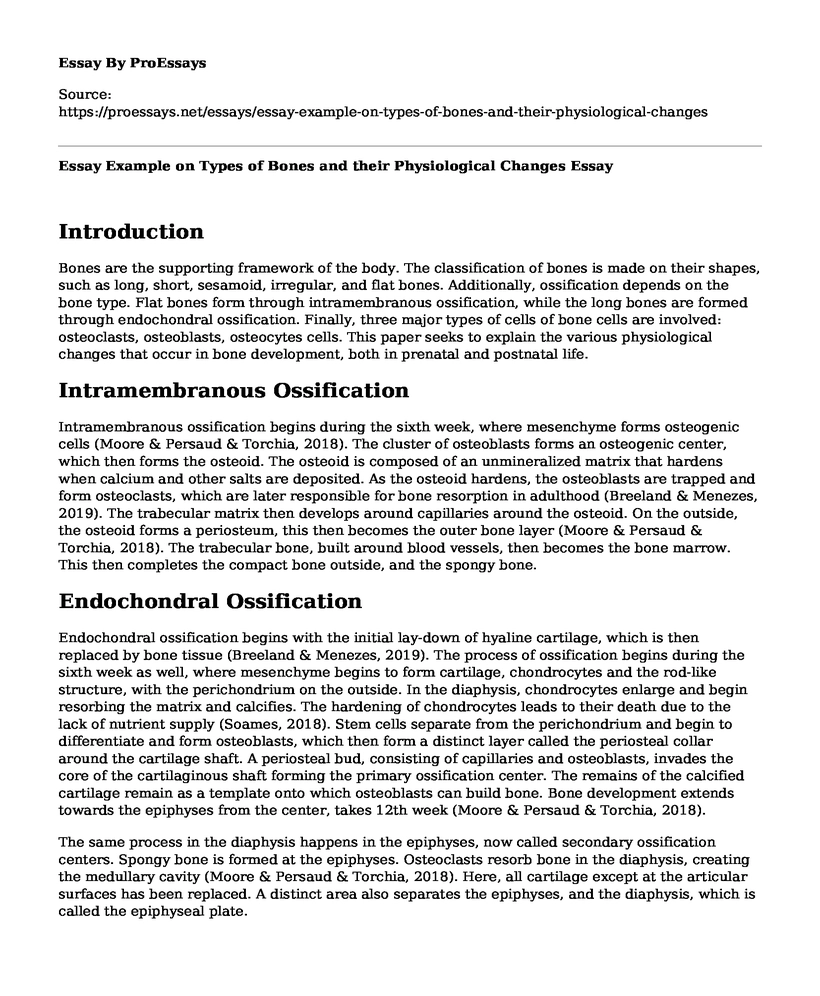Introduction
Bones are the supporting framework of the body. The classification of bones is made on their shapes, such as long, short, sesamoid, irregular, and flat bones. Additionally, ossification depends on the bone type. Flat bones form through intramembranous ossification, while the long bones are formed through endochondral ossification. Finally, three major types of cells of bone cells are involved: osteoclasts, osteoblasts, osteocytes cells. This paper seeks to explain the various physiological changes that occur in bone development, both in prenatal and postnatal life.
Intramembranous Ossification
Intramembranous ossification begins during the sixth week, where mesenchyme forms osteogenic cells (Moore & Persaud & Torchia, 2018). The cluster of osteoblasts forms an osteogenic center, which then forms the osteoid. The osteoid is composed of an unmineralized matrix that hardens when calcium and other salts are deposited. As the osteoid hardens, the osteoblasts are trapped and form osteoclasts, which are later responsible for bone resorption in adulthood (Breeland & Menezes, 2019). The trabecular matrix then develops around capillaries around the osteoid. On the outside, the osteoid forms a periosteum, this then becomes the outer bone layer (Moore & Persaud & Torchia, 2018). The trabecular bone, built around blood vessels, then becomes the bone marrow. This then completes the compact bone outside, and the spongy bone.
Endochondral Ossification
Endochondral ossification begins with the initial lay-down of hyaline cartilage, which is then replaced by bone tissue (Breeland & Menezes, 2019). The process of ossification begins during the sixth week as well, where mesenchyme begins to form cartilage, chondrocytes and the rod-like structure, with the perichondrium on the outside. In the diaphysis, chondrocytes enlarge and begin resorbing the matrix and calcifies. The hardening of chondrocytes leads to their death due to the lack of nutrient supply (Soames, 2018). Stem cells separate from the perichondrium and begin to differentiate and form osteoblasts, which then form a distinct layer called the periosteal collar around the cartilage shaft. A periosteal bud, consisting of capillaries and osteoblasts, invades the core of the cartilaginous shaft forming the primary ossification center. The remains of the calcified cartilage remain as a template onto which osteoblasts can build bone. Bone development extends towards the epiphyses from the center, takes 12th week (Moore & Persaud & Torchia, 2018).
The same process in the diaphysis happens in the epiphyses, now called secondary ossification centers. Spongy bone is formed at the epiphyses. Osteoclasts resorb bone in the diaphysis, creating the medullary cavity (Moore & Persaud & Torchia, 2018). Here, all cartilage except at the articular surfaces has been replaced. A distinct area also separates the epiphyses, and the diaphysis, which is called the epiphyseal plate.
Bone growth in adulthood occurs at the epiphyseal plate (Allen & Burr, 2019). It has the uppermost zones, the reserve zone, and the proliferative zone, which multiply via mitosis and supplies chondrocytes to the zone of maturation and hypertrophy. This zone allows the maturation and multiplication of chondrocytes to supply the zone of calcification below it. The zone of calcification has mature chondrocytes that have calcified and are dead. The osteoblasts form the diaphysis, penetrate this area, and provide osteoblasts on top of the calcified cartilage increasing bone length. Bones grow until late adulthood, where the chondrocytes are replaced by bone tissue, and an epiphyseal line replaces the plate. Appositional growth occurs by osteoclasts resorbing old bone and replacing it with new osteoblastic activity. This increases the medullary cavity, as well as the diaphysis diameter.
References
Allen, M. R., & Burr, D. B. (2019). Bone Growth, Modeling, and Remodeling. In Basic and Applied Bone Biology (pp. 85-100). Academic Press.
Breeland, G., & Menezes, R. G. (2019). Embryology, bone ossification. In StatPearls [Internet]. StatPearls Publishing.
Moore, K. L., Persaud, T. V. N., & Torchia, M. G. (2018). The Developing Human-E-Book: Clinically Oriented Embryology. Elsevier Health Sciences.
Soames, R. W. (2018). Anatomy and Human Movement E-Book: Structure and function. Elsevier Health Sciences.
Cite this page
Essay Example on Types of Bones and their Physiological Changes. (2023, Jul 12). Retrieved from https://proessays.net/essays/essay-example-on-types-of-bones-and-their-physiological-changes
If you are the original author of this essay and no longer wish to have it published on the ProEssays website, please click below to request its removal:
- How Inuk Use Seal and Seal Products Essay
- Why Animals Should Be Excluded From Circuses Essay Example
- Research Paper on Scaffold-Based Method
- Anatomy and Physiology: Speech Language Pathology Paper Example
- Prairie Vole Empathy - Annotated Bibliography
- Animal Testing: Unethical and Inhumane Practice - Essay Sample
- Essay Example on 82% Decline in Wild Mammal Biomass: What Endangers Species?







